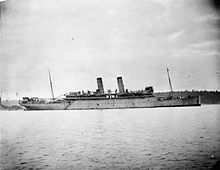Otranto (ship, 1909)
|
||||||||||||||||||||||||
|
||||||||||||||||||||||||
|
||||||||||||||||||||||||
|
||||||||||||||||||||||||
|
||||||||||||||||||||||||
The Otranto (I) was a 1909 passenger ship of the British shipping company Orient Steam Navigation Company , which was used in passenger and mail traffic from Great Britain to Australia . As an auxiliary cruiser , the Otranto was involved in the sea battle at Coronel . Used as a troop transport from June 1918 , it collided with another transport on October 6, 1918 and sank. 431 men drowned.
Passenger ship
The 12,124 GRT steamship Otranto was built at Workman, Clark & Co. Ltd. built in Belfast , Northern Ireland . The Otranto was launched on March 27, 1909 . She was delivered on June 30, 1909 and spent the summer of 1909 on tourist trips in northern European waters. On October 1, 1909, she left London for her first trip to Melbourne , Sydney and Brisbane via Suez . It was built for mail and passenger services on this route. On June 6, 1911, the ship took part in the Coronation Fleet Review in Spithead on the occasion of King George V's coronation .
The 163.2 meter long and 19.5 meter wide passenger and mail ship had two chimneys, two masts and two propellers and was powered by two quadruple expansion steam engines that developed 12,000 PSi and enabled a speed of 18 knots. The ship had space for 280 passengers in the first, 130 in the second and 900 in the third class. The crew consisted of 350 people.
The Otranto was one of a series of five identical sister ships , all of which were commissioned for the Australian route between 1909 and 1911. The other four were the Otway (12,077 GRT), the Orvieto (12,133 GRT), the Osterley (12,129 GRT), the Orsova (I) (12,136 GRT) and the Orama (I) (12,927 GRT).
Auxiliary cruiser
One week after the British declaration of war on the German Reich in August 1914, the Otranto was confiscated by the Admiralty to be converted into an auxiliary cruiser . It was armed with four 4.7 inch (120 mm) guns.
She was sent to the South Atlantic to join the West Indies Squadron under Rear Admiral Sir Christopher Cradock . This squadron was then sent to the Southeast Pacific to stop the German East Asia Squadron under Vice Admiral Maximilian von Spee . Otranto discovered the German squadron on November 1, 1914 off the Chilean coast. In the subsequent naval battle at Coronel , she broke off the battle with the SMS Dresden early on and escaped to the south, as did the light cruiser HMS Glasgow .
After the battle, the HMS Otranto served as a guard ship on the Falkland Islands , but returned to Great Britain in January 1915, as the civilian crew threatened to mutinate. From May 1915 the Otranto was back in the Pacific and monitored the west coast of America. She was overtaken four times during her time in the Pacific. The first and last overhauls were carried out in Sydney , Australia, in February 1916 and April 1918, respectively. In Esquimalt (British Columbia) , Canada, the other two repairs took place in October 1916 and October 1917. After the last overhaul, she was ordered back to Great Britain and was used as a troop transport from June 1918. It has now been used in the North Atlantic.
Downfall
On October 6, 1918, the HMS Otranto collided with the former P&O liner and now troop transport Kashmir in poor visibility and rough seas between the Irish coast and the Outer Hebrides of Scotland. She had a large leak on the port side forward and got heavy seas list . The ship drifted into the Machir Bay on the island of Islay on a rock and ran to there. The swell pushed the Otranto further against the rocks, so that it finally broke and sank. The sinking claimed 431 lives. In addition to 80 men of the British occupation, 351 US soldiers died.
Alarmed by the SOS calls, the destroyer HMS Mounsey of the Yarrow M class was able to dissuade over 300 people from the drifting Otranto , which it brought to Belfast , where they were taken to hospitals. 17 men managed to swim ashore. Many of the dead were buried in Belfast and Islay, but the Americans were returned to the United States from 1920.
literature
- Geoffrey Bennett: The sea battles of Coronel and Falkland and the sinking of the German cruiser squadron under Admiral Spee (= Heyne books. 5697). Heyne, Munich 1980, ISBN 3-453-01141-4 .
- Robert Gardiner (Ed.): Conway's All the World Fighting Ships 1906-1921. Conway Maritime Press Ltd, London 1985, ISBN 0-85177-245-5 .
- Hans H. Hildebrand, Albert Röhr, Hans-Otto Steinmetz: The German warships. Biographies, a mirror of naval history from 1815 to the present. 7 volumes. Mundus, Ratingen 1995, ISBN 3-88385-028-4 .
- Jane's fighting ships of World War I. Studio Editions, London 1990, ISBN 1-85170-378-0 .
- Arnold Kludas : The ships of Hamburg-Süd. 1871-1951. Gerhard Stalling, Oldenburg et al. 1976, ISBN 3-7979-1875-5 .
- Maria Theresa Parker de Bassi: Cruiser Dresden. Odyssey of No Return. , Koehlers Verlagsgesellschaft mbH, Herford 1993, ISBN 3-7822-0591-X .
- Roger Chesneau, Eugene M. Kolesnik (Ed.): Warships of the world 1860 to 1905. Volume 1: Great Britain and Germany. Bernard & Graefe, Koblenz 1983, ISBN 3-7637-5402-4 .


